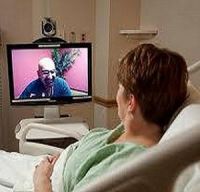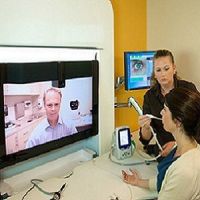The American College of Physicians (ACP) has issued policy recommendations for the practice and use of telemedicine in primary care. In a position paper published in the Annals of Internal Medicine, the ACP said it supports the expanded role of telemedicine as a way to increase access to care and reduce costs. However, benefits offered by telemedicine "must be measured against the risks and challenges associated with its use," according to the ACP.
The organisation calls upon physicians to use their judgement in determining when remote care is appropriate. To that end, the ACP recommends that telemedicine be used when a patient and a physician have an established, ongoing relationship, and then "only as an intermittent alternative to a patient's primary care physician when necessary to meet the patient's immediate acute care needs."
A physician using telemedicine who has no direct previous contact with the patient must attempt to establish the same sort of relationship required for an in-person visit, the ACP says, or consult with another physician who does have a history with that patient.
The ACP paper also recommends:
The recommendations put forward by ACP are largely intended for the use of telemedicine in primary care. The ACP said it "recognises that the application and principles for the use of telemedicine for specialities and subspecialities can vary depending on the situation, care setting, or standard of care."
The ACP paper is a follow-up to one written in 2008 titled "E-Health and Its Impact on Medical Practice," which addressed the use of technology including electronic health records, patient portals and telemedicine.
The debate of whether a patient-provider relationship is necessary before use of telemedicine is ongoing in the industry. For example, the Georgia Composite Medical Board requires that a face-to-face encounter with a patient occur before a telehealth service is delivered, with some exceptions. In Ohio, a face-to-face examination is not needed to provide a telemedicine service if the physician can gather the same information through the telemedicine encounter as they would through a face-to-face visit encounter.
Source: American College of Physicians
Image credit: Flickr.com
The organisation calls upon physicians to use their judgement in determining when remote care is appropriate. To that end, the ACP recommends that telemedicine be used when a patient and a physician have an established, ongoing relationship, and then "only as an intermittent alternative to a patient's primary care physician when necessary to meet the patient's immediate acute care needs."
A physician using telemedicine who has no direct previous contact with the patient must attempt to establish the same sort of relationship required for an in-person visit, the ACP says, or consult with another physician who does have a history with that patient.
The ACP paper also recommends:
- Developing evidence-based guidelines and clinical guidance on appropriate use of telemedicine to improve patient outcomes;
- That telehealth activities address the needs of all patients without disenfranchising financially disadvantaged populations or those with low literacy or low technologic literacy;
- That streamlined processes be established for obtaining licensure in multiple states while allowing states to retain individual licensing and regulatory authority;
- Lifting Medicare's geographic restrictions on reimbursement, and providing reimbursement for telemedicine communications, whether synchronous or asynchronous, provided by text, voice, video or device feeds.
The recommendations put forward by ACP are largely intended for the use of telemedicine in primary care. The ACP said it "recognises that the application and principles for the use of telemedicine for specialities and subspecialities can vary depending on the situation, care setting, or standard of care."
The ACP paper is a follow-up to one written in 2008 titled "E-Health and Its Impact on Medical Practice," which addressed the use of technology including electronic health records, patient portals and telemedicine.
The debate of whether a patient-provider relationship is necessary before use of telemedicine is ongoing in the industry. For example, the Georgia Composite Medical Board requires that a face-to-face encounter with a patient occur before a telehealth service is delivered, with some exceptions. In Ohio, a face-to-face examination is not needed to provide a telemedicine service if the physician can gather the same information through the telemedicine encounter as they would through a face-to-face visit encounter.
Source: American College of Physicians
Image credit: Flickr.com
References:
Daniel H and Sulmasy LS, for the ACP Health and Public Policy Committee
(2015) Policy Recommendations to Guide the Use of Telemedicine in Primary Care Settings: An American College of Physicians Position Paper.
Ann Intern Med. 8 September 2015 doi: 10.7326/M15-0498
Latest Articles
healthmanagement, American College of Physicians, eHealth, telemedicine, patient-physician relationship
The American College of Physicians (ACP) has issued policy recommendations for the practice and use of telemedicine in primary care. In a position paper published in the Annals of Internal Medicine, the ACP said it supports the expanded role of telemedici



























